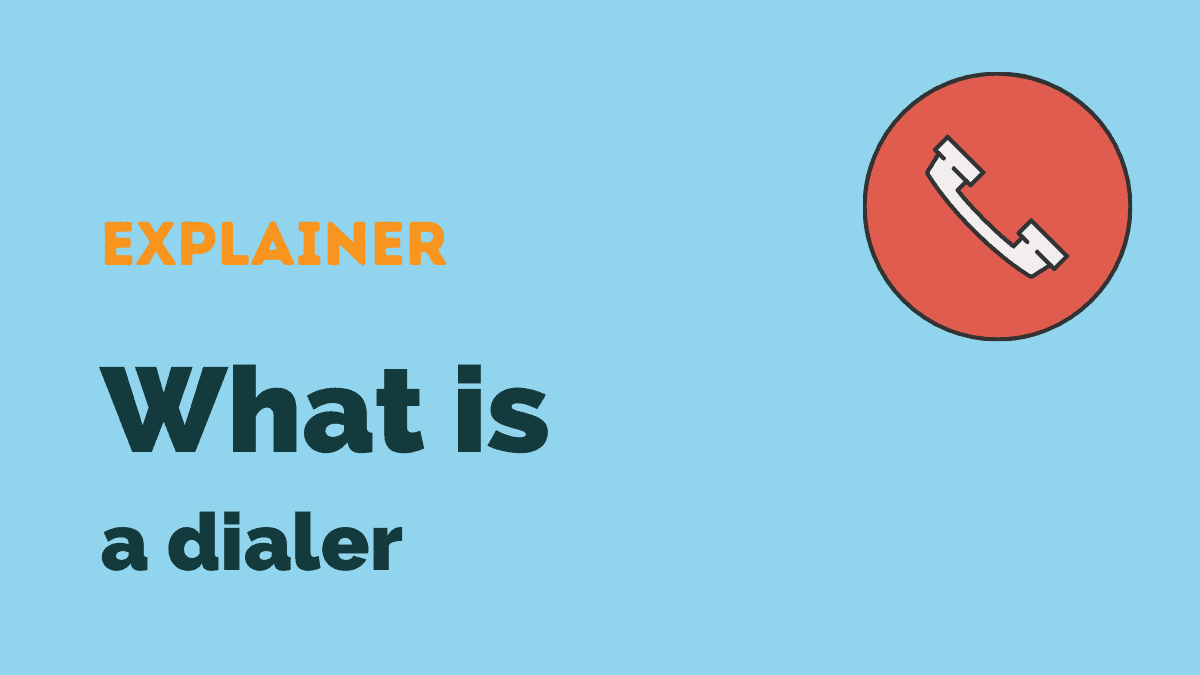In this post:
- Introduction to dialers
- What does a dialer look like?
- What are the different kinds of dialer?
- A little bit of dialer history
- Dialer concerns
- What processes are dialers used for?
- How do integrated dialers work?
What is a dialer?
A dialer is an automated system that places calls to customers, from an outbound call center or a blended call center.
The aim is to reduce the cost of making phone calls by removing a lot of repetitive and error-prone work.
Dialers also improve efficiency by connecting agents directly to customers as soon as they are free.
Automated dialing means that contact center agents don’t waste time physically inputting telephone numbers. Instead, they can spend more of each call talking to customers!
Want more articles like this in your inbox? Click here to get our fortnightly CX newsletter.
What does a dialer look like?
Early dialers were pieces of hardware, but these days they’re usually software-based.
Apart from that, the definition of a dialer is quite fluid.
There are also different categories of dialer, each of which focus on various areas of performance.
(To add additional confusion, there is rarely any agreement on what these different types of dialer should be called!)
What are the different kinds of dialer?
There’s a long list of dialer ‘types’.
Some of these types have important and fundamental difference. Others are just the same old dialers, marketed under a new name!
Power dialer
A power dialer offers a simple kind of outbound dialing.
The dialer sees that an agent has ended a call, and immediately calls the next number on your list.
If the recipient answers, the dialer bridges the call to the agent. If there is no answer, the dialer moves on to the next number.

Predictive dialer
A predictive dialer calls multiple numbers at the same time, using an algorithm to detect two things:
- when an agent will be available, and
- the likelihood that the agent will get through to the intended recipient.
As with all auto dialer technology, the aim is to waste less time.
Contact centers also cut down on wasted time with a variety of supporting technologies that detect answering machines, busy signals, or numbers that are no longer in service.
Adaptive dialer
In most cases, an adaptive dialer offers the same functionality as a predictive dialer.
The same is generally true of things like ‘dynamic dialers’ – the functionality depends on the vendor and your contact centers integration strategy.
If a contact center has a strong integration strategy, an adaptive dialer may also access and use data in resources like your call center CRM or cloud helpdesk software.
In practice that means your dialer can base some of its decision making on what you already know about the customer. Are they especially high value, or a churn risk?
These all use some form of algorithm or mechanism to decide:
- When to dial out to callees
- The likelihood of having an employee available
The ideal dialer should be deeply embedded in your businesses’ surrounding technology and processes for making calls.
In many ways, a modern dialer is only a tiny part of the overall solution needed to create integrated communications processes for sales, service and other parts of a business.
For example, a customer may be scheduled for an outbound call based on an online query.
But what if the customer makes an inbound call first?
Or what if they have already had an email conversation that dealt with their issue?
This is where you need automation to remove the (now unnecessary) outbound call from your schedule, or to provide the latest information to the employee.
Otherwise, you’ll miss out on the intended efficiency gain of using a dialer in the first place!
In a modern multichannel context, you need an entire set of integrated processes to ensure that the dialer takes data from other systems into account.
A little bit of dialer history
The purpose of dialers has changed over time as new capabilities have been added.
The first dialers were only capable of working through a list of contact numbers. They didn’t change without manual intervention, and they didn’t make predictions.
Without additional behaviors or contextual information, their only real purpose was linking sales staff to potential prospects for telemarketing.
In contrast, a modern dialer can be programmed with an enormous amount of contextual data, and deployed for practically any campaign. This includes after-sales calls, lead nurturing, or proactive customer service.
Unfortunately, the early uses of dialers have led to a generally negative public perception of practices like cold calling.
Dialer concerns
Although dialer solutions are now very advanced, plenty of contact centers still use dated technology. This leads to some concerns about the use – or misuse – of outbound dialers.
For example, call centers may place more calls than they can handle, leading to silent or abandoned calls. Many territories around the world now have strict guidelines in place to prevent so-called ‘nuisance calls’.
In the UK, Ofcom and the Information Commissioner’s Office have dramatically increased penalties for silent or abandoned calls. In other countries there are usually regulations with similar intent.
But while this has cost some companies a lot of money, it’s generally good news for the industry. By raising the standard of practice, watchdog organizations are making life harder for businesses that damage the reputation of contact centers, while also protecting consumers.
What processes are dialers used for?
Nowadays dialers are integrated with all kinds of business processes. When a consumer requests a call-back through a website, it’s likely that the call-back is processed by a dialer integrated with CRM, the company websites and other systems.
If a consumer gets a call to check that they have not been a victim of fraud – perhaps because a warning was automatically generated from unusual activity – then that’s also most likely done using an integrated dialer.
Of course, dialers are used by sales teams, including cold calls and automated outbound messaging. But the list of applied processes is very long, and goes well beyond sales; account reactivation, customer retention, proactive customer care, and debt collection are just a few.
In many cases, the calls generated by the dialer are either requested by the consumer, or, in the case of debt collection, essential to the functioning of a financial service.
How do integrated dialers work?
There are essentially two approaches to integrating dialers into the other systems and channels. The first is packaged dialers which have pre-built integrations for common tools, particularly for CRM systems. This mainly benefits very small teams and simple use cases.
The second approach allows components of a dialer and the surrounding systems to integrate freely with any other system. When teams need more flexibility and have complex processes requiring ongoing optimization, this approach is usually preferable.
The key thing to note is that the dialer itself – the function placing and connecting calls – is just one part. It’s the integration and process automation around the dialer component that actually enables businesses to communicate in sales and customer service.





